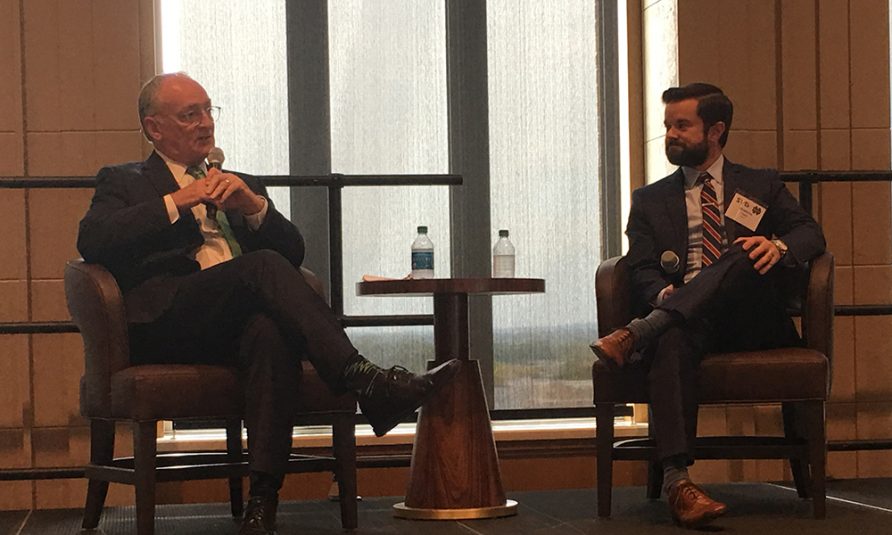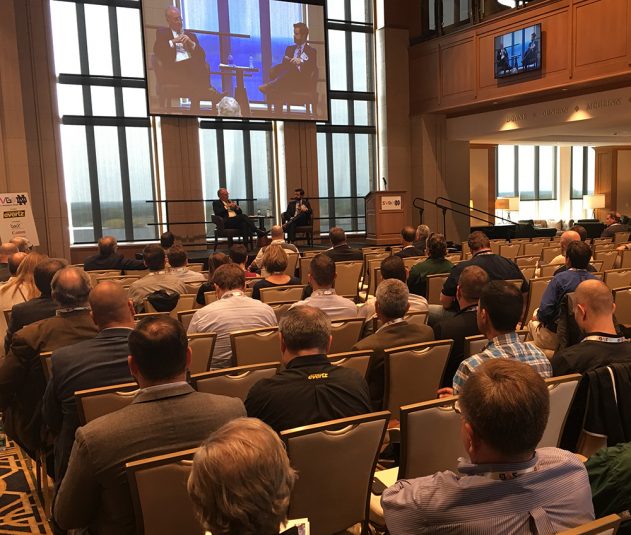SVG@Notre Dame Event Takes 100+ Video Pros Behind the Scenes at State-of-the Art Stadium, New Media Center
Keynote Conversation with Notre Dame’s Jack Swarbrick offered in-depth look at the Campus Crossroads Project
Story Highlights
SVG headed to the University of Notre Dame this week, as more than 100 sports-video–production leaders arrived in South Bend, IN, for a one-of-a-kind two-day event: SVG@Notre Dame. The event on Oct. 10-11 featured behind-the-scenes tours and panel sessions providing an overview of the recently completed renovations to Notre Dame Stadium and the new Rex and Alice A. Martin Media Center, as well as an in-depth look at the state-of-the-art Campus Crossroads Project. The event kicked off with a Keynote Conversation with Notre Dame VP/Director of Athletics Jack Swarbrick, who discussed the thinking behind the largest construction initiative in Notre Dame history.
“[Originally, in 1930, Knute] Rockne built the Stadium off-campus, and campus has grown up around the stadium,” said Swarbrick. “But the geographic center of Notre Dame is now the northwest corner of the end zone. The real-estate issue was that you can’t use the center of your campus seven times a year. So the inquiry became, What is the model for the future of this stadium that gives it every-day, year-round vitality?”
The revamped Notre Dame Stadium embraces both the old and the new. Although the most eye-catching element may be the 10-mm (4.8 million total pixels), 54- x 95.5-ft. wide Mitsubishi LED videoboard, the aesthetic of the overhauled facility emphasizes Notre Dame Stadium’s rich history: throughout the concourse, brick and reclaimed wooden benches line the walls, and banners of classic game programs float overhead.
“We recaptured the history of the place,” Swarbrick pointed out. “We had lost it during the expansion 20 years ago when the second level was put on and they just poured concrete. We went in and recaptured the concourse. We bricked the concrete and put in period lighting to celebrate the past and recapture the sense of the 1930s stadium.”
At the heart of the renovated stadium is the 18,000-sq.-ft Martin Media Center, which supports all university video-content- and multimedia-creation efforts. From digital content in support of academics and faith-based programming/initiatives to production of videoboard shows in Notre Dame Stadium, Purcell Pavilion, and Compton Family Ice Arena, it will be a resource for students, faculty, and staff.
“The great thing about this for me is that, years ago, when we first went to the university and said, ‘Let’s build the university’s media function in athletics as a beta test, and, once we’ve built it, we can then import it into the rest of the university,’” Swarbrick explained. “And that’s exactly what has happened.
“If this were viewed as [solely] an athletics project, we aren’t sitting here right now,” he added. “It was a university project that athletics helped launch and was quick to turn over to the university to take the lead on it.”
On Day 2 of the event, staff from the University of Notre Dame and the newly launched Notre Dame Studios took the stage to delve deeper into the Campus Crossroads Project and how it will impact athletics, faith-based programming, and academics. In addition, key vendors involved in the design, integration, and implementation process detailed various aspects of the Martin Media Center and the Campus Crossroads project as a whole — from systems integration and routing to audio and intercoms to storage and media-asset-management (MAM).
The Martin Media Center, which was integrated by Beck TV, features two control rooms, two audio rooms, and six edit rooms, as well as a teaching studio, an academic-innovation space, and a variety of facilities to cater to all aspects of Notre Dame content creation. It is built around an Evertz EXE IP router with SDVN orchestration and control (capable of 46-Tbps switching) and features nine Grass Valley LDX 86 WorldCams (seven hard, two handheld) with Canon lenses, an Evertz DreamCatcher replay system (including four slo-mo workstations, 36 input channels, 12 slo-mo playback, and 12 linear playback), a pair of Ross Acuity 4M/E switchers, Ross Xpression studio graphics, Telos Alliance Axia Fusion audio consoles, a Riedel Artist Intercom system, Studio Technologies announcer consoles, and Evertz VIP multiviewers feeding 55 screens.
“The thing I love about the media center, which reflects the core value of what we’re trying to do here, is that, although it’s a media center in a football stadium, it’s not an athletics facility,” said Swarbrick. “It is also for faith and academic programming, student education, and then also athletics programming. It represents in so many ways what we were [trying to accomplish]. The rest of the [renovation] has [department]-specific functionality, … but the media center is everybody. Everybody touches it and uses it, and it’s a great resource for the university.”
Notre Dame is also building out a comprehensive MAM and storage ecosystem (integrated by CineSys-Oceana), which is built around the CatDV MAM platform and Spectra Logic Black Pearl converged storage system. Notre Dame Studios is also using Quantum’s Xcellis Workflow Storage Platform as their high-performance shared storage for collaborative workflows powered by StorNext. As it evolves in the coming year, this ecosystem will manage and store all Notre Dame media content – not just video – campus-wide.
SVG would like to thank Swarbrick, Notre Dame Studios Executive Director Dan Skendzel, Director of Broadcast Technology Scott Rinehart, Fighting Irish Digital Media Executive Producer of Live Events Mike Bonner, and the entire University of Notre Dame staff for graciously hosting the event. SVG@Notre Dame was made possible by Title Sponsor Evertz and Event Sponsors BeckTV, Canon, Imagine Communications, and Quantum.
Karen Hogan Ketchum and Ken Kerschbaumer contributed to this story.


